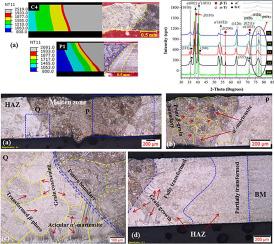Optics & Laser Technology ( IF 4.6 ) Pub Date : 2020-07-02 , DOI: 10.1016/j.optlastec.2020.106456 Bikash Kumar , Swarup Bag , C.P. Paul , C.R. Das , R. Ravikumar , K.S. Bindra

|
The transients and gradients generated due to localized heating and cooling by a laser source governs the thermal-metallurgical-mechanical performance of the welded structure. An attempt is made to investigate the significance of the pulse parameter over continuous mode in Yb-fiber laser welding of 800 μm thin Ti6Al4V alloy. The full-depth of penetration with minimum weld width is achieved at the lowest heat input of 12 J/mm for the pulse laser. The behaviour pattern of the thermal history is critically assessed with the aid of FE based heat transfer model and corresponding relation with evolved microstructural morphologies are systematically investigated. Several stages of transformation occurred in the weld zone such as -phase dissolution, -transus in the heating cycle, and diffusionless martensitic transformation during the cooling cycle are well explained by thermal history. A relatively high amount of -martensite is observed in the pulse laser welding whereas the transformed -phase fraction gradually reduces further away from the weld line. Blocky plate-shaped -martensite within the coarse-grain boundary is apparent at higher heat input (26–80 J/mm), whereas acicular morphology within the fine-grain boundary is observed at a low heat input of 12–19 J/mm. The dimensional variation of -lath at the fusion zone has a significant influence on strength. Weld metal containing very fine -lath have comparable strength to that of the base metal. The images of the fractured surface shows the dimples as well as microspores in continuous mode, whereas combinations of large and small dimples are observed for pulse mode of welding. The level of contamination is examined by surface discoloration technique and found to be the highest for the heat input of 80 J/mm.
中文翻译:

激光焊接参数模式对薄Ti6Al4V合金显微组织形态的影响
由于激光源的局部加热和冷却而产生的瞬变和梯度控制着焊接结构的热冶金机械性能。试图研究脉冲参数在800μm薄Ti6Al4V合金的Yb光纤激光焊接中连续模式下的重要性。在脉冲激光的最低热量输入为12 J / mm的情况下,可以以最小的焊接宽度实现全焊透深度。借助基于有限元的传热模型对热历史的行为模式进行了严格评估,并系统地研究了与演变的微观结构形态的对应关系。焊接区发生了几个转变阶段,例如相溶解 -在加热循环中是连续的,并且不扩散 冷却过程中的马氏体相变可以通过热历史很好地解释。相对较高的脉冲激光焊接观察到马氏体,而相变 相分数逐渐减小,远离焊接线。块状板状内马氏体热输入(26–80 J / mm)时,晶粒边界明显,而细晶粒内的针状形态-在12-19 J / mm的低热量输入下观察到晶界。的尺寸变化熔合区的板条对强度有重要影响。焊接金属含极细-板条具有与贱金属相当的强度。断裂表面的图像显示了连续模式下的凹坑和微孢子,而脉冲模式的焊接则观察到了大凹坑和小凹坑的组合。通过表面变色技术检查污染程度,发现其热量输入为80 J / mm时最高。











































 京公网安备 11010802027423号
京公网安备 11010802027423号